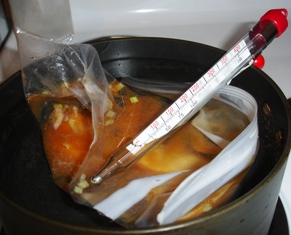food fads

You know how it is. Carrot cake, “Shake ‘n Bake” and tofu in my childhood in the 1970s, cold pasta salad and stuffed potato skins in the 1980s, “nouvelle cuisine” in the 1990s with every portion cut in half and every sauce reduced to a sticky spoonful, and anything fat-free in the noughties (appropriately enough!). These trends pop up everywhere, and overnight everyone is eating them and maybe even cooking them. Some of them even take up a permanent place in our diets, like arugula — my personal favorite.
Like everything else in the super-modern world, food fads are speeding up. Especially in a big international city like London, every year it seems something new takes the food world by storm. I’m not much of one for going out to restaurants as you know — preferring the comfort of my own kitchen. But it’s important to go out now and then just to see what innovative, mad trend has taken hold for the moment.
Two years ago, it was “sous-vide,” a French technique for cooking everything under the sun vacuum-packed in a hot-water bath. I’ll admit it: we bought a vacuum packer and filled an enormous stockpot with hot water, cooking a leg of lamb for 150 hours or some such nonsense. It was funny to try, but in the end a bit silly. That was that for sous-vide and moi.
 Last year saw an atrocious development called “foam,” or “espuma,” known in our household as “spit.” Every lovely piece of meat in a trendy restaurant was topped with a spoonful of Emperor’s New Clothes in the form of bubbly spit. “Basil foam,” “celeriac foam.” It was spit.
Last year saw an atrocious development called “foam,” or “espuma,” known in our household as “spit.” Every lovely piece of meat in a trendy restaurant was topped with a spoonful of Emperor’s New Clothes in the form of bubbly spit. “Basil foam,” “celeriac foam.” It was spit.
This year, from what I can see, the fad is everything turned into “dirt.” I am cautiously optimistic and even tempted to make some dirt of my own. The concept is this: you cook an ingredient to the point of dehydration, then you crumble it into a crunchy handful and scatter it over the dish. For example, the photograph at the top of this post is from our absolute favorite new restaurant, The Corner Room at the Town Hall of Bethnal Green. It’s squid topped with chorizo dirt. Savoury, simple, unexpected, crunchy and strangely exciting.
This same restaurant serves a dish of venison loin covered in ash, sprinkled with… dirt made from rye breadcrumbs soaked in squid ink and dehydrated. Heaven!
The other new fad I see all around is poaching. This can be done in a sous-vide manner, or as I like to do, poached in a shallow amount of olive oil. The Corner Room offers this completely innovative dish of poached cod in a clam porridge, drizzled with a coriander pesto. I know, it sounds MAD. But in the right hands, these new, daft, jolly techniques can raise food to a level where every mouthful is a delightful surprise.
 The older I get, the less tolerant I am of paying anyone to cook for me something I could cook for myself. That’s what makes the Corner Room and restaurants like it - l’Etranger in Kensington, for example — such fun to patronize. Ingredients you might not think to pair at home (foie gras and tuna tartare!), cooked in a way you would never imagine, techniques beyond my skill!
The older I get, the less tolerant I am of paying anyone to cook for me something I could cook for myself. That’s what makes the Corner Room and restaurants like it - l’Etranger in Kensington, for example — such fun to patronize. Ingredients you might not think to pair at home (foie gras and tuna tartare!), cooked in a way you would never imagine, techniques beyond my skill!
I’m hot on the trend here in England for nose-to-tail eating. The idea behind this rather felicitous phrase is that if we’re going to kill animals to eat them, we should eat ALL of them. It’s just too bad that the term for all the parts of the animal that Americans don’t want to eat is “offal.” Liver, kidneys, sweetbreads, hearts: the butchering term simply means any part of the animal that is interior, inside other parts. And my new hands-down favorite: beef cheeks.
Sadly I cannot give you a photograph of this dish because like so many of my homely, cozy, slow-cooked dishes, it is just awful to look at. But do give it a try.
Beef Cheeks Slow-Braised with Mushrooms
(serves 4)
2 beef cheeks, trimmed of sinew (but don’t go crazy trimming)
2 tbsps vegetable oil
1 white onion, diced
6 cloves garlic, minced
2 carrots, diced
6 large-ish mushrooms, quartered or cut in eighths depending on size
2 tbsps chopped thyme leaves
1/2 bottle good red wine
chicken or veal stock to cover
Slice the beef cheeks in half to make a portion per person. In a heavy ovenproof dish with a lid, heat the oil and saute the beef cheeks just briefly on all sides and remove to a dish. In the remaining oil, saute all vegetables till soft. Add the thyme, cheeks and the wine, then add enough chicken stock for the meat and vegetables to be completely, generously covered. Place in a low oven, 300F/160C, covered. Cook for at least four hours and serve with noodles or mashed potatoes.
************
Now this is a food fad I can get behind. It’s morally upright, it’s the most inexpensive cut of beef on earth, it’s fun to say. It’s also foolproof, cooks itself and falls apart on your fork. You will never eat a more heartwarming, comforting cut of beef.
Get out then, out of the kitchen and pop into a trendy but not silly restaurant. Suspend disbelief and order some dirt, or an innard. Even an innard topped with dirt. See if you’re not inspired.


And what would beef cheeks be labeled here in the good old US of A? I just might try it! Can’t wait to see you in July at the Winnebago reunion!
Well, Auntie L, if you were fortunate enough to find a butcher, I think they’d be called just the same! Can’t wait to see you, too.
I agree — I can’t really imagine ordering beef cheeks in my local Giant… and I think the neighborhood butcher has long gone the way of the streetcar, and the town itself for that matter, outside of those 2 or 3 cities that actually still exist in America. You can probably get it online, packed in dry ice. Such a shame when I live in the land of the original family farm. Even the farmers markets here sell factory farmed meat that comes from other states…
I know, Work, it’s a real cultural tragedy. Apparently there are traditional Mexican recipes that cook the cheeks — in fact the whole head! — for breakfast! And some people report that cheeks can often be found in ground beef in America. But the cut itself is just lovely. I can’t believe what you say about your farmers markets. Well, I can, but I don’t want to.
At the Lancaster central market they have people dressed up in Amish costumes selling vegetables that are not even in season — probably from Chile or something. It’s distressing. The real Amish farms can’t make a living by selling to the handful of customers for the real thing, so they are probably the worst in terms of factory farm abuses. There was an expose recently about a local “organic” chicken farm where the chickens were held in worse conditions than any corporate conglomerate would allow. And they were hiring illegal migrant workers who they were paying well below minimum wage… “Locally sourced” just is not the same here as it is over there. Maybe there are exceptions, but I have decided to stick to the supermarket.
This whole scenario — the costumes, the low pay, the factory animals — is seriously creeping me out. Supermarket sounds better and better. At least they have legal standards.